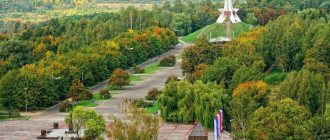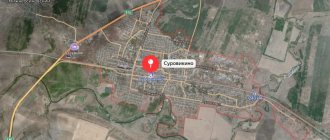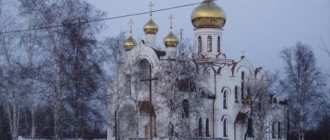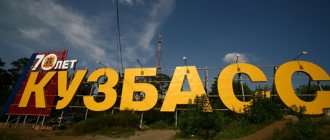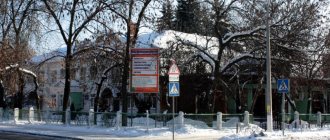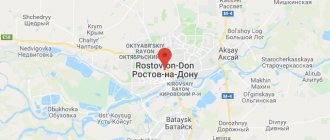Tomsk region
includes 7
urban settlements
, including[1][2]:
- 6 cities, among which stand out: 4 cities of regional subordination ( highlighted in orange
) - within the framework of the organization of local self-government they form separate city districts, - 2 cities of district subordination (within the framework of the organization of local self-government they are included in the corresponding municipal districts);
- within the framework of the organization of local self-government, it is included in the corresponding municipal district.
Where is she located
It is located almost in the very center of Russia, with a slight shift to the south. In the east it borders with the Krasnoyarsk Territory. In the west - with the Tyumen and Omsk regions. From the south it is limited by the Novosibirsk and Kemerovo regions. Finally, from the north and northwest, the region surrounds the Khanty-Mansiysk Autonomous Okrug.
Located in the depths of the Eurasian continent, the region has a rather harsh climate - continental. Warm air masses from the west do not reach here, cut off by the Ural Mountains. Therefore, summers here are very hot, but winters can be quite harsh, snowy and cold. Needless to say, this is real Siberia in all its glory!
History of the region
The Russian people came to these lands at the end of the sixteenth and beginning of the seventeenth centuries. The oldest settlement built here was the city of Narym. It was founded in 1596 and exists to this day, although it has lost the status of a city and today is a village.
Life for the settlers was dangerous and difficult. It was necessary to clear the land for arable land, prepare all the resources, from firewood to food, and often fight off wild animals, of which there were a lot here at that time. The local residents – Tomsk Tatars, Khanty, Selkups – also caused a lot of problems. They did not immediately appreciate the benefits that they received after their ancestral lands became part of the powerful empire. It is impossible to list numerous skirmishes and even battles in one article - for this one would have to write a whole book. However, Russian settlers successfully defended their right to life and developed these inhospitable but rich lands.
And just a few years later, in 1604, the settlers founded a new city - Tomsk. It developed successfully and by 1629 became the center of the Tomsk category, which included several counties: Surgut, Narym, Kuznetsk, Yenisei, Krasnoyarsk and Ket.
However, Tomsk did not always remain the center of these places. Over the past centuries, the administrative division has changed several times. For example, in 1708, the Tomsk district became part of the Siberian province, the center of which was located in Tobolsk.
Almost a century later - in 1782 - the Tomsk region was separated from the Tobolsk governorship - this decision was made personally by Catherine the Great. Two decades later, the Tomsk province appeared on the map of the Russian Empire, which existed for more than a century. In 1925, a wave of reforms swept across the country, and the province became part of the Siberian Territory. Only in August 1944 did the Tomsk region reappear - some of the districts that were part of the Tomsk and Narym districts were separated from the Novosibirsk region.
The administrative boundary drawn three quarters of a century ago remains the same today.
Map
| Tomsk: maps |
Tomsk: photo from space (Google Maps) Tomsk: photo from space (Microsoft Virtual Earth)
| Tomsk Nearest cities. Distances in km. on the map (in brackets along roads) + direction. Using the hyperlink in the distance , you can get the route (information courtesy of the AutoTransInfo website) | |||
| 1 | Timiryazevskoe | 5 (8) | Z |
| 2 | Zone Station | 8 () | YU |
| 3 | Light | 12 (27) | NE |
| 4 | Seversk | 13 (20) | NW |
| 5 | Moryakovsky Zaton | 29 () | NW |
| 6 | Samus | 31 () | NW |
| 7 | Melnikovo | 55 (64) | Z |
| 8 | Taiga | 62 (300) | SE |
| 9 | Kozhevnikovo | 66 (101) | SW |
| 10 | Yashkino (Kemerovo region) | 75 (109) | YU |
| 11 | Anzhero-Sudzhensk | 80 (157) | SE |
| 12 | Yurga | 87 (99) | YU |
| 13 | Asino | 91 (122) | NE |
| 14 | Yaya (Kemerovo region) | 96 (185) | IN |
| 15 | Bolotnoe | 99 (140) | YU |
| 16 | Pervomayskoye | 100 (134) | NE |
| 17 | Zyryanskoe | 107 (131) | IN |
| 18 | Izhmorsky (Kemerovo region) | 108 (200) | IN |
| 19 | Krivosheino | 113 (169) | NW |
a brief description of
The city is located in the southeast of the West Siberian Plain, on the right bank of the river. Tom, 60 km from its confluence with the Ob, and on the banks of the river. Ushayka, 3500 km from Moscow.
The climate is continental. The average temperature in January is -20, in July +18. Precipitation is 500 mm per year.
Railway station. River port. Road junction.
Territory (sq. km): 295
Information about the city of Tomsk on the Russian Wikipedia site
Historical sketch
Founded in 1604 as a Russian fortress on the river. Tom called Tomsk prison. Since 1629 it has been the center of the region, the trade and craft center of Siberia. Gidronym Tom researchers of the 18th century. derived from Ket tom, tom “river”; modern authors deny the terminological meaning of this word and allow the formation of tom from the Ket tum “dark, black” or interpret tom as the Turkic-Mongolian “big, main”.
In the 17th century played a significant role in the defense of the Russian border from the invasion of steppe nomads. In 1614, 1617, 1657, 1698 repelled the raids of the Kyrgyz and Kalmyks. In the 18th century In connection with the advancement of the state border to the south and the construction of border fortifications in Northern Altai, the strategic importance of Tomsk decreased. Some of the Cossacks from the city were transferred to the Biysk and Ust-Kamenogorsk fortresses.
From 1708 in the Siberian province, in 1719 it was assigned to the Tobolsk province, from 1724 in the Yenisei province, from 1726 again in the Tobolsk province. Since 1736 in the Tobolsk General Government. Since 1782 - a regional city of the Tobolsk governorship (since 1796 - Tobolsk province).
With the construction of the Siberian Highway (from Moscow to Irkutsk), Tomsk acquired important importance in transit trade. Leather and soap production, blacksmithing and carpentry were developed. The population of Tomsk and surrounding villages was engaged in carting. Since 1804, Tomsk has been the center of the Tomsk province.
Gold mining in the Tomsk and Yenisei provinces since the late 1830s. strengthened the trade and transit importance of Tomsk. In 1822-63. The Tomsk civilian was at the same time the main head of the Altai mining plants. The Mining Office was located in Tomsk.
In 1856, in the provincial city of Tomsk, Tomsk province, there were 14 churches, 1946 houses, 265 shops.
During the construction of the Trans-Siberian Railway to Tomsk in 1896, a railway line was laid and a railway was built. workshops. The city began to grow rapidly and acquired the role of a major economic and cultural center of Siberia.
In 1880, the first university in the Asian part of Russia was founded here, in 1896 - the first higher technical educational institution in Siberia - the Technological Institute.
At the beginning of the 20th century. New branches of production arose - sleeves, furniture, etc.
Since 1944 - the center of the Tomsk region.
Municipal indicators
| Index | 1990 | 1999 | 2001 | 2003 | 2005 |
| Demography | |||||
| Number of births, per 1000 population | 11.8 | 8.7 | 9.9 | 11 | 11.4 |
| Number of deaths, per 1000 population | 8.3 | 11.2 | 11.8 | 12.6 | 12.5 |
| Natural increase (decrease), per 1000 population | 3.5 | -2.5 | -1.9 | -1.6 | -1.1 |
| Standard of living of the population and social sphere | |||||
| Average monthly nominal accrued wages, rub. | 0.324 | 1641 | 3685 | 7135 | 10631.3 |
| Average housing area per inhabitant (at the end of the year), sq.m. | 13.3 | 16.5 | 17.2 | 17.9 | 18.7 |
| Number of preschool institutions, pcs. | 129 | 90 | 90 | 90 | 87 |
| Number of children in preschool institutions, thousand people | 23.5 | 14.4 | 15.3 | 16.1 | 16 |
| Enrollment of children in preschool educational institutions (at the end of the year), as a percentage of the number of children of the corresponding age, % | 65.9 | 66.2 | |||
| Number of daytime educational institutions (at the beginning of the school year), pcs. | 60 | 87 | 87 | 87 | 88 |
| Number of students in daytime educational institutions, thousand people | 57.9 | 60.5 | 55 | 49.1 | 44.9 |
| Number of doctors, people. | 4913 | 4926 | 4898 | 4830 | 5075 |
| Number of nursing staff, people. | 6988 | 6117 | 6167 | 6085 | 6121 |
| Number of hospital institutions, pcs. | 36 | 36 | 33 | 34 | 34 |
| Number of hospital beds, thousand units | 9.2 | 8.2 | 8.1 | 7.7 | 7.7 |
| Number of medical outpatient clinics, pcs. | 55 | 55 | 60 | 69 | 84 |
| Capacity of medical outpatient clinics, visits per shift, thousand units. | 13.7 | 14.6 | 15.1 | 14.7 | 14.8 |
| Number of registered crimes, pcs. | 10419 | 12193 | 12901 | 14828 | 19177 |
| Persons who committed crimes were identified, persons. | 2383 | 6794 | 6788 | 4445 | 5366 |
| Economy, industry | |||||
| Number of enterprises and organizations (at the end of the year), pcs. | 1375 | 15434 | 18242 | 21715 | 23306 |
| Number of operating enterprises by type of activity: mining (at the end of the year), pcs. | 15 | ||||
| Number of operating enterprises by type of activity: manufacturing (at the end of the year), pcs. | 238 | ||||
| Number of operating enterprises by type of activity production and distribution of electricity, gas and water (at the end of the year), pcs. | 88 | ||||
| Volume of shipped goods of own production by type of mining (in actual prices), million rubles. | 537.2 | ||||
| Volume of shipped goods of own production by type of manufacturing (in actual prices), million rubles. | 26941.7 | ||||
| Volume of shipped goods of own production by type of production and distribution of electricity, gas and water (in actual current prices), million rubles. | 9438.6 | ||||
| Construction | |||||
| Volume of work performed by type of activity “Construction” (until 2004 - volume of work performed under construction contracts), million rubles. | 0.179 | 1302.3 | 3780.9 | 6451.8 | 5386.3 |
| Commissioning of residential buildings, thousand sq.m. of total area | 244.9 | 127.3 | 139.5 | 156.8 | 249.3 |
| Commissioning of residential buildings, apartments | 4037 | 1717 | 1816 | 2466 | 4275 |
| Commissioning of preschool institutions, places | 560 | 0 | 0 | 0 | 0 |
| Commissioning of educational institutions, places | 2442 | 0 | 0 | 0 | 0 |
| Commissioning of hospital facilities, beds | 0 | 0 | 0 | 60 | 0 |
| Commissioning of outpatient clinics, visits per shift | 0 | 0 | 0 | 350 | 200 |
| Transport | |||||
| Number of bus routes (in intracity traffic), pcs. | 22 | 22 | 17 | 13 | 7 |
| Number of tram routes, pcs. | 4 | 5 | 5 | 5 | 5 |
| Length of operational tram tracks (at the end of the year), km | 20.5 | 20.5 | 20.5 | ||
| Number of trolleybus routes, pcs. | 5 | 7 | 7 | 7 | 7 |
| Length of operational trolleybus lines (at the end of the year), km | 35.7 | 39.1 | 39.1 | ||
| Number of passengers transported by buses per year (in intracity traffic), million people. | 115.9 | 98.2 | 106.4 | 107.2 | 109.5 |
| Number of passengers transported by trams per year, million people. | 38 | 45.3 | 91.6 | 95.3 | 15.8 |
| Number of passengers transported by trolleybuses per year, million people. | 31.2 | 71.7 | 113.7 | 100.1 | 21.9 |
| Connection | |||||
| Number of telephone sets of the city public telephone network, thousand units. | 72.1 | 142.9 | 163.3 | 182.2 | 198.1 |
| Number of residential telephone sets of the city public telephone network, thousand units. | 39.8 | 104.4 | 115.3 | 127.3 | 138.1 |
| Number of payphones of the city telephone network (including universal ones), pcs. | 1086 | 1069 | |||
| Trade and services to the population | |||||
| Retail trade turnover (in actual prices), million rubles. | 0.809 | 6466 | 11462 | 21058 | 34647 |
| Retail trade turnover (in actual prices), per capita, rub. | 0.159 | 13413 | 23701 | 43089 | 68149 |
| Index of physical volume of retail trade turnover, % compared to the previous year | 117.5 | 117.8 | |||
| Index of physical volume of public catering turnover, % compared to the previous year | 113.7 | 116.2 | |||
| Number of stores, pavilions (at the end of the year), pcs. | 84 | 179 | |||
| Sales area of shops, pavilions (at the end of the year), sq.m. | 12548.3 | 54745.7 | |||
| Volume of paid services to the population (in actual prices), million rubles. | 0.161 | 1660 | 3542 | 7645.5 | 12868.9 |
| Volume of paid services to the population (in actual prices), per capita, rub. | 0.3 | 3448 | 7325 | 15645 | 25313 |
| Volume of household services to the population (in actual prices), million rubles. | 0.041 | 432.9 | 675 | 834.9 | 1264.3 |
| Volume of household services to the population (in actual prices), per capita, rub. | 0.081 | 899 | 1396 | 1708 | 2487 |
| Investments | |||||
| Investments in fixed assets (in actual prices), million rubles. | 0.36 | 4175 | 7652 | 9246 | 12879.8 |
| Share of investments in fixed assets financed from budgetary funds in the total volume of investments, % | 10.7 | 11.6 | 11.8 | 13.6 | |
Data sources:
- Regions of Russia. Main characteristics of the constituent entities of the Russian Federation: statistical collection. Goskomstat of Russia. - M:, 2003.
- Regions of Russia. Basic socio-economic indicators of cities. Statistical collection. Rosstat. - M:, 2005.
- Transport in Russia: Statistical collection. Goskomstat. - M:, 2003. pp. 110, 112, 120, 122
- Transport in Russia: Statistical collection. Rosstat. - M:, 2005. pp. 117, 119, 127, 129
- Regions of Russia. Basic socio-economic indicators of cities. 2006. Statistical collection. Rosstat. - M:, 2006. p. 331
Culture, science, education
Scientific Center of the Russian Academy of Sciences, which includes the following institutes: Siberian Physics and Technology, Nuclear Physics, Cable Industry, Vaccines and Serums, Physical Methods of Treatment and Balneology.
Research institutes: chemistry, oil, atmospheric physics.
6 universities, including: Tomsk State and Polytechnic.
Institutes: civil engineering, automated control systems and radio electronics, medical pedagogical.
Theatres: regional drama, regional puppet theater, young spectators. Philharmonic.
Museums: local history, art. University museums: archeology and ethnography of Siberia, zoological, mineralogical, paleontological. Siberian Botanical Garden named after. P.N. Krylova.
Museums, galleries, exhibition halls
Zoological Museum of Tomsk State University 634050, Tomsk, Lenin Ave., 36 Website: https://zoomuseum.tsu.ru/
Museum of Archeology and Ethnography of Siberia, Tomsk State University 634050, Tomsk, Lenin Ave., building 36
Museum complex of Tomsk Polytechnic University 634050, Tomsk, Lenin Ave., 30
Tomsk Museum of Wooden Architecture 634000, Tomsk, Kirova Ave., 7 Telephone(s): 41-0097
Tomsk Regional Museum of Local Lore named after M.B. Shatilova 634050, Tomsk, Lenin Ave., 75 Phone(s): (3822) 51-2935 Website: https://tomskmuseum.ru/
Tomsk Regional Art Museum 634050, Tomsk, lane. Nakhanovicha, 5 Phone(s): (3822) 51-4106 Website: https://artmuseum.tomsk.ru/
Architecture, sights
Tomsk has a regular street layout with main highways running parallel to the river in the meridian direction. The development of the historical part of the city is a combination of a large number of preserved stone administrative and public buildings with blocks of wooden residential buildings with rich carvings.
Architectural monuments: Church of the Resurrection (1789-1807), stone shopping arcades or Gostiny Dvor (18th century), magistrate (1802-12), public places (1830-42), etc.
Since the 1970s. In Tomsk, a lot of work is being done to research and restore architectural monuments.
Among the modern buildings: the educational building of the Polytechnic Institute (1952-54), the House of Culture (1957).
The city is surrounded by small tracts of cedar, fir, pine and birch park forests.
| Population by year (thousands of inhabitants) | |||||||
| 1856 | 20.2 | 1967 | 324 | 1998 | 478 | 2013 | 548.0 |
| 1897 | 52.2 | 1970 | 338.4 | 2000 | 482.1 | 2014 | 557.2 |
| 1914 | 114.7 | 1973 | 374 | 2001 | 483.4 | 2015 | 564.9 |
| 1923 | 75 | 1976 | 398 | 2003 | 487.8 | 2016 | 569.3 |
| 1926 | 83.7 | 1979 | 420.7 | 2005 | 487.4 | 2017 | 572.7 |
| 1931 | 100.7 | 1982 | 449 | 2006 | 489.9 | 2018 | 574.0 |
| 1934 | 130.0 | 1986 | 483 | 2007 | 493.0 | 2019 | 575.4 |
| 1939 | 145.1 | 1989 | 502.0 | 2008 | 496.5 | 2020 | 576.6 |
| 1956 | 224 | 1992 | 504.7 | 2010 | 508.6 | 2021 | 568.5 |
| 1959 | 248.8 | 1996 | 473 | 2011 | 524.7 | ||
| 1962 | 275 | 1997 | 483.4 | 2012 | 539.2 | ||
total area
Now we can talk about the area and extent of the Tomsk region. From north to south it stretches for almost 600 kilometers. But from west to east – more than 780 kilometers. Thus, the area of the Tomsk region in sq. km is 314,391. By Russian standards, not too much - only 16th place among regions and other administrative units. But when compared with European countries, these sizes are very impressive. This is slightly larger than Poland - one of the largest states in Europe, 2.5 times larger than Greece, 3.5 times larger than Iceland. And about seven countries like Switzerland could fit here, and there would still be room for almost all of Moldova.
Most of this territory is occupied by forests - almost 63% of impenetrable, wild Taiga. Unfortunately, in recent years, forests have been rapaciously destroyed - mostly by Chinese entrepreneurs, who often do not have licenses to carry out logging.
There are a lot of swamps here - they account for almost a third of the territory of the Tomsk region. The area of the swamps is almost 91 thousand hectares.
The altitude above sea level is not too high - there are no large hills, not to mention mountains. The highest point is 274 meters above sea level, and the lowest is 34 meters.
Water resources
It is not surprising that, given the low altitude and abundance of forests, these places are rich in water resources. The total number of streams and rivers exceeds 18 thousand. Of course, not all of them are large, but still there are more than one and a half thousand rivers more than 10 kilometers long. Well, the main water artery of the region was and remains the Ob, connecting it with many other regions - starting with Altai at the source and ending with the Yamalo-Nenets Autonomous Okrug at the mouth, where the river flows into the Ob Bay, which is part of the Kara Sea. The Ob has many tributaries, each of which flows into the river in the Tomsk region. The largest ones include: Ket, Chaya, Tom, Vasyugan, Chulym, Tym, Parabel. The navigation period here is quite long - about six months, which gives all navigable rivers strategic importance.
There are also many lakes here. For many fishermen, Lake Glukhoe is of particular interest, where pike, crucian carp, perch and other fish are found. The area of Lake Glukhoye in the Tomsk region is about 10 square kilometers.
Strezhevoy
Coat of arms of the city of Strezhevoy
The coat of arms of the city of Strezhevoy was adopted on September 8, 2004. At the top there is a bezant of variable colors, from which a black stream flows. In the green field there is a cedar cone with needles, in the silver field there is an oil derrick. The silver field symbolizes the desire to preserve the surrounding nature, the blue field is the land of rivers, lakes and swamps. A tower with a circle and a black stream pouring out of it symbolizes the oil industry. The green field symbolizes the nature surrounding the city. A pine cone indicates forest wealth.
Administrative structure
As you know, the area of the Tomsk region in sq. km exceeds 314 thousand. Of course, for easier administration, the entire territory is divided into several administrative units. Moreover, it is divided quite unevenly – we’ll talk about this a little later.
In total, the region consists of twenty urban districts and districts. The largest regional center in terms of population is the city of Tomsk. Almost 595 thousand people live here. According to this indicator, he is in first place. But in area it is much smaller than most other administrative units. Despite the impressive total area of the Tomsk region, the territory of the regional center is only 295 square kilometers.
The largest administrative unit in these parts by area is the Kargasok district. Its area is close to 87 thousand square kilometers. But the population is surprisingly small - less than 20 thousand people.
The Verkhneketsky district with an area of 43,349 square kilometers is almost twice as large as the leader. Very few people live here – less than 16 thousand people.
The smallest district is Kozhevnikovsky. Its area is only 3,908 square kilometers, but in terms of population it is not inferior to, or even surpasses, the largest districts of the region: more than 20 thousand people.
The Zyryansky district is only slightly ahead of it. Its area is slightly larger - 3966 square kilometers, but its population is almost half as much - 11 thousand people. And this is on a territory almost twice the size of such a prosperous state as Luxembourg, whose population is almost 600 thousand people.
As you can see, the population and areas of the districts of the Tomsk region are distributed very unevenly. This is influenced by the size of areas suitable for living, the availability of jobs and simply historical factors.
What is the meaning of the name of the city Tomsk?
Architecture and midges. There is a legend that Omsk is an abbreviation that stands for Remote Place of Exile for Convicts, and Tomsk is EVEN MORE Remote Place of Exile for Convicts. ... TOMSK - July 8. The letter “K” shyly hid in the bushes.
Interesting materials:
How many balloons are there in 40 liters of helium? How old is Shatunov Jura? How many chocolates are there in a large Mercy box? How many pieces of Nuggets are there in a pack of Miratorg? How many pieces of ceiling tiles are in a package? How many rolls are there in 1 serving? How long does a dog last? How many cm is Gon? How many cm does a plasterboard ceiling take? How much formula do they give in the dairy kitchen?
Number and density of population
The total number of residents here, according to the 2022 census, is only 1 million 78 thousand people. Of course, given the huge area of the Tomsk region in hectares (about 26.7 million), this is surprisingly small - only 3.4 people per square kilometer.
Of course, the population is distributed extremely unevenly. In cities, the density increases significantly, for example, in Tomsk the density is 1947 people per square kilometer. In smaller settlements it is measured in hundreds of people. But around these tiny spots on the map lie thousands of square kilometers of swamps and forests, where people either do not visit at all or visit only temporarily, traveling from one city to another.
By the way, many people would be interested in what the residents of the city of Tomsk are called - the name formed according to standard templates sounds very unusual. In fact, their name is Tomsk.
The percentage of urbanization in the region is quite high. More than 72% of the population lives in cities. The highest density was recorded in settlements located along the banks of the Ob and its tributaries. This is not an accident at all - getting out of many populated areas in the spring thaw, as well as in the winter snowstorm, can be very difficult. But rivers do an excellent job of serving as roads, allowing you to travel almost all year round without fear of getting stuck in the mud.
Question answer
Which cities in Siberia have airports?
In all those included in the top 8 rating of this article. Even in Tobolsk with a population of 100 thousand, a new Remezov airport opened in September 2022. Now you can get to the tiny but beautiful Siberian town from Moscow and St. Petersburg.
Which Siberian cities are considered the most touristic?
Of the above - Irkutsk, Tomsk and Tobolsk. Tour operators, in the wake of the development of domestic tourism, are actively promoting Novosibirsk and Tyumen (including regional attractions). Krasnoyarsk, Kemerovo and Omsk are visited exclusively for tourism purposes only by true fans.
National composition
The lion's share of local residents, according to the 2010 census, are Russian - more than 92%, or 922,723 people. The next largest nation is sharply inferior - only 1.7% of Tatars live here.
In third place, also noticeably behind, are the Ukrainians. At the time of the last census, just over 11 thousand Ukrainians lived here, or 1.12%.
There are also Germans here, and not so few of them - approximately 0.87%, or 8687 people.
Azerbaijanis close the top five peoples most common in the Tomsk region. In 2010, a little more than 2 thousand representatives of this people lived here, which is 0.4% of the total population.
In general, here you can see representatives of dozens of peoples, both local (Chulym, Yakut, Khanty) and very exotic for these places (Vietnamese, Yezidis, Jews, Greeks). Of course, the number of most of them is extremely limited and mostly amounts to only a few hundred people - less than 0.01%.
Such a varied composition is easy to explain. During Soviet times, industry actively developed here - both mining, manufacturing, and agriculture. Therefore, people came here from all over the Soviet Union - teachers, builders, geologists, doctors, drivers, workers and many, many others.
In post-Soviet times, the region began to concentrate on the extractive industry - primarily oil. Serious salaries attract many residents from other areas.
In recent years, the number of Chinese has increased sharply. Immigrants from China receive the right to logging or simply begin logging on their own. Of course, as a more understandable and cheaper labor force, influential and richer loggers prefer to use their compatriots, many of whom come without paperwork.
Alas, the area of the Tomsk region in km2 is about 314,000, and it is very difficult to control it. Therefore, it is unknown when the situation here will change and whether it will change at all.
Industry
The entire industry of the region is based on such main sectors as oil production, mechanical engineering, and non-ferrous metallurgy.
Today, almost half of the GDP from all industry comes from oil production - about 49%. Mechanical engineering accounts for 13%, which is also a serious indicator showing that the region not only uses natural gifts, but also produces high-quality equipment that is in stable demand.
The Siberian Chemical Plant, although it is one of the largest in Russia, specializing in working with radioactive materials, is gradually losing its importance. Thus, in 2004 it brought only 9% of GDP, while in 2001 this figure exceeded 20%. However, management is not going to give up and is actively using innovative technologies, introducing new projects. For example, it is planned to begin production of titanium dioxide, lithium tetrafluoroborate, sodium fluoride and a number of stable isotopes - all these raw materials are in stable demand both in Russia and abroad, which will provide a large sales market.
Agriculture is represented by both crop production and meat and dairy farming, and breeding of fur-bearing animals, which are of particular value.
Also in the region you can see many large joint ventures involved in oil production and logging.
About the city
| Strezhevoy, a city in the Russian Federation, Tomsk region, is located in the southeast of the Middle Ob Plain, on the bank of the right channel of the river. Ob, 70 km from the Nizhnevartovsk railway station, 931 km northwest of Tomsk. Population 43.0 thousand people (2001). Founded in 1966. City since 1978. Oil and gas production center of the Sosninsko-Sovetskoye field. Oil pipeline to Anzhero-Sudzhensk, gas pipeline to Kuzbass. "Tomskneftegeofizika". Center of the agricultural region: state farms “Strezhevskoy”, “Severny”, “Teplichny”. The village of Strezhevaya was built in the 1930s. special settlers. In 1966, the village of Strezhevoy was founded near the village; since 1967, it has been an urban-type settlement, inhabited by oil workers serving drilling stations within a radius of 200 km. The city has a training center of the Tomsk Engineering and Construction Institute. | Strezhevoy. City center |
Interesting Facts
Now you know the area of the Tomsk region in hectares and square kilometers, you have an idea of its population, industry and history. You can cite several not so important, but quite interesting facts that will reveal this area and its center from a completely new, unexpected side.
Tomsk can boast of a large number of monuments, many of which are distinguished by their originality. So, while walking along the streets of the city, you can come across monuments to the ruble, cabbage, slippers, and beaver. But perhaps all of them are overshadowed by the monument depicting a wolf from the famous Soviet cartoon “Once upon a time there was a dog,” where the now catchphrase was uttered: “I’ll sing now!”
From the eighteenth century until the October Revolution, the Tomsk region was a place where political prisoners were sent. For example, in the first half of the nineteenth century, every fifth resident of these places was an exile.
Tomsk universities, which are the hallmark of the city, have produced such famous instructors as M. Mil (creator of the Mi series helicopters), N. Kamov (helicopter developer), N. Nikitin (architect who designed the Ostankino TV tower).
Mikhail Andreev, who composed the song “Poplar fluff, heat, July,” which was a real hit for several years, played on radio and television, was inspired by the landscapes of this particular glorious city. In addition, he wrote the song “Tram Pyaterochka”. True, this text had to be edited a little later. The fact is that it featured a rather unusual name for the local district - Cheremoshniki. The toponym is unusual, so it was replaced with Cheryomushki - such areas exist in many cities of the country, so preference was given to the popular option. But from Cheremoshniki it was really possible to get to the city center by tram route No. 5, until it was abolished.
